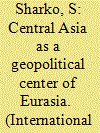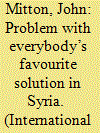|
|
|
Sort Order |
|
|
|
Items / Page
|
|
|
|
|
|
|
| Srl | Item |
| 1 |
ID:
191725


|
|
|
|
|
| Summary/Abstract |
The recent Russian invasion of Ukraine has led many commentators to remark that ‘geopolitics is back’. And with geopolitics, the interest in buffer zones is back as well. Yet, International Relations scholarship on buffer zones is confusing and outdated. Scholars disagree on the definition of buffer zones and whether such zones are a vestige of the great power politics of the past or a continuous phenomenon. In this article, we take three steps to reconceptualize buffer zones and their role in international relations. First, we clarify the conceptual confusion by advancing a new definition differentiating between nominal and active buffer zones. Second, we make the case that buffer states and internal buffer zones (i.e., geographic borderlands located within states in rivalry, adjacent to the international borders between the two rivals) share much in common and therefore should be analysed in tandem. Third, we offer a typology of buffer zones with short case-studies based on the dyadic relations of rival states vis-à-vis buffer zones between them. Our goal is to provide a new analytical framework that can serve as a base for a robust research agenda on the role of buffer zones in regional and international stability and security.
|
|
|
|
|
|
|
|
|
|
|
|
|
|
|
|
| 2 |
ID:
127477


|
|
|
|
|
| Publication |
2013.
|
| Summary/Abstract |
WORLD GEOPOLITICS has entered another post-crisis period which will create a much greater interest in developing economies and regions. The biggest world powers not so long ago holding forth about the Anglo-American liberal economic model as allegedly better suited to navigate the stormy sea of globalization lost the battle. Today, Central Asia (an umbrella term for Kazakhstan, Kyrgyzstan, Tajikistan, Turkmenistan, and Uzbekistan) which has not yet exhausted its natural riches came to the fore as one of the promising developing regions.
|
|
|
|
|
|
|
|
|
|
|
|
|
|
|
|
| 3 |
ID:
123263


|
|
|
|
|
| Publication |
2013.
|
| Summary/Abstract |
This analysis examines the link between 'indirect rivalry factors' - situations in which states are neighbors of direct US rivals, and/or states that share rivalries in common with the US - and allocations of foreign aid to shed light on the impact of strategic calculations on a key area of foreign policy behavior. Blending literatures on rivalry/conflict and foreign aid, the study is situated in the relevant prior work and a theory is developed that links indirect rivalry factors with allocations of foreign aid. It is argued that indirect rivalry factors are likely to affect a state's foreign assistance as states in a rivalry strategically allocate aid to create friends and isolate their targeted rivals. In particular, it is argued that donors direct greater amounts of aid to (i) other states involved in a rivalry with the donor's rivals (rivalries in common, or 'rivals of my rival' effects) and (ii) states within the geographic region in which the donor's existing rivals are situated (neighborhood effects, or 'neighbors of rivals'). Hypotheses on the effects of these indirect rivalry factors on aid allocations are developed and then tested empirically against US foreign aid allocations from 1962 to 2000. The results lend support to the authors' theory of indirect rivalry factors and their impact on aid allocation.
|
|
|
|
|
|
|
|
|
|
|
|
|
|
|
|
| 4 |
ID:
172338


|
|
|
|
|
| Summary/Abstract |
Given the conventional claim that external threats increase internal cohesion and government capacity, cross-country studies have examined how interstate conflict events influence domestic politics. This article reevaluates the in-group and out-group mechanisms by examining how international strategic rivalry, which indicates the presence of persistent external threats even in the absence of military conflict, affects domestic political competition. An alternative explanation suggests that the effect of external threats on political incentives of domestic actors differs between regime supporters and oppositions. We posit that the presence of international threats from rival states inflames domestic unrest and oppositions’ antiregime challenges, while making governments rely more on repressive tactics given resource constraints and a high level of domestic political intolerance. In addition, we propose that the domestic consequences of international rivalry are heterogeneous depending on the characteristics of political systems and the level of threat perception. Empirical tests reveal robust evidence for the hypotheses.
|
|
|
|
|
|
|
|
|
|
|
|
|
|
|
|
| 5 |
ID:
135209


|
|
|
|
|
| Summary/Abstract |
In discussions of NATO’s failure in Afghanistan, there is an increasing recognition of the damaging influence of competition between India and Pakistan. Yet, while reference to “rivalry” abounds, few authors connect Indian and Pakistani behaviour to the established literature on international rivalry. This paper corrects this explanatory gap by applying findings from the subfield of rivalry research. States engaged in rivalry behave differently; each issue of contention is fused into the broader rivalry relationship. For India, influence in Afghanistan is a component of its regional strategy, designed to maintain dominance over Pakistan in South Asia. For Pakistan, influence in Afghanistan is sought primarily for the opportunity to confront, damage, and frustrate Indian aims. The result is continued violence and instability. For policymakers, an appropriate appreciation of the strategic and political realities in a given region is a prerequisite for future international interventions in order to avoid such complications.
|
|
|
|
|
|
|
|
|
|
|
|
|
|
|
|
| 6 |
ID:
146496


|
|
|
|
|
| Summary/Abstract |
As the United States, Canada, and other Western and world allies attempt to devise workable policies vis-à-vis the Syrian crisis, a common thread links many if not most putative policy “solutions”: the need to engage local coalitions of regional actors to provide the military muscle to defeat the Islamic State, thereby setting the stage for a workable political solution to restore stability to the country as a whole. Given the experiences of Iraq and Afghanistan, neither the US nor its allies are particularly keen on deep involvement in Syria. Unfortunately, cultivating and encouraging increased involvement from regional actors (including Sunni Arab nations with, ostensibly, a “vested interest” in defeating the Islamic State) risks promoting long-term instability and conflict as regional political rivals—in particular Iran and Saudi Arabia—exploit and exacerbate the conflict for their own purposes. In a worst-case scenario, this could even contribute to a broader regional war along sectarian (Sunni–Shia) lines.
|
|
|
|
|
|
|
|
|
|
|
|
|
|
|
|
|
|
|
|
|